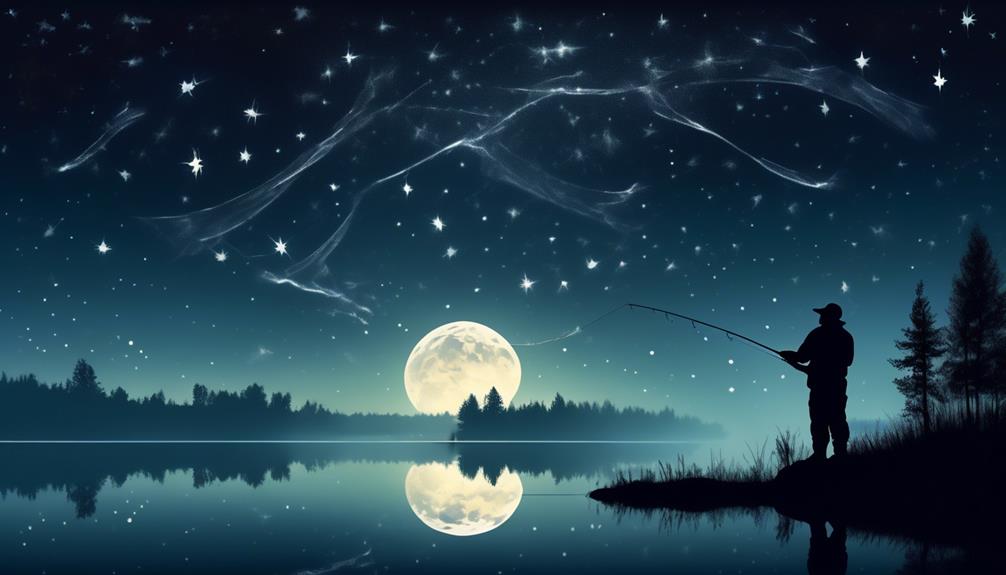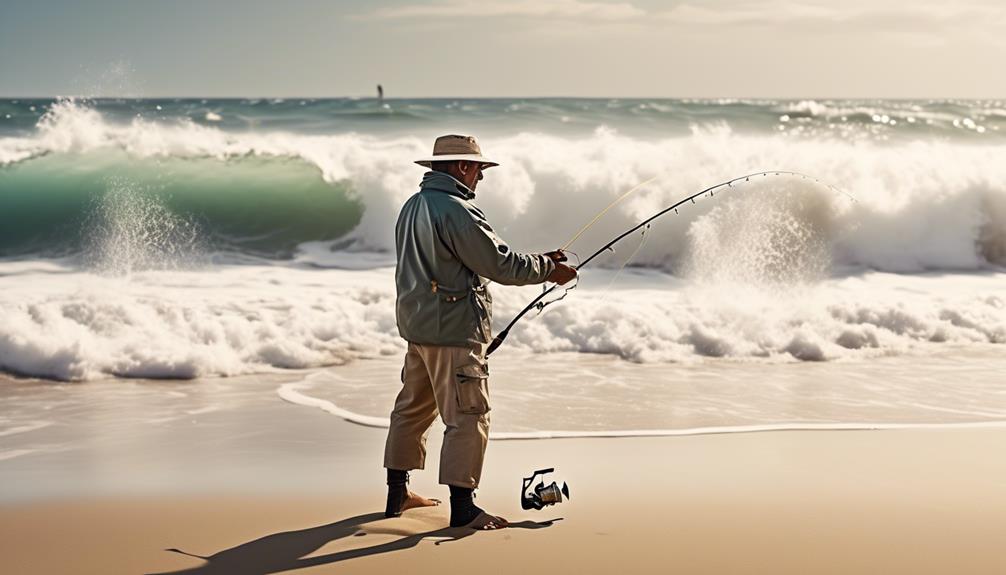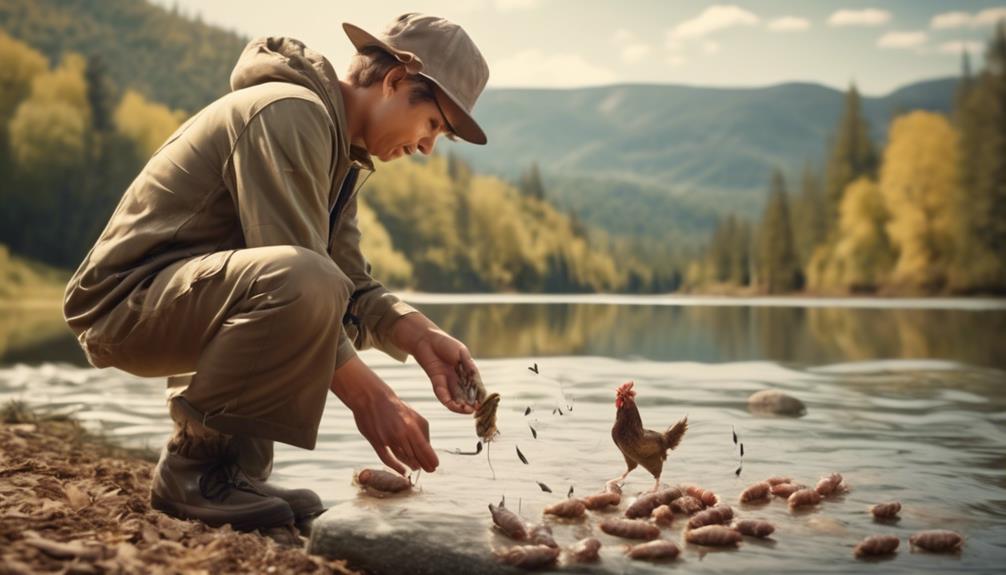So, you've decided to try your hand at night walleye fishing. It's no secret that walleye are notorious for being more active during the evening hours, but how do you ensure a successful catch in the dark?
There are several key techniques and strategies that can significantly increase your chances of reeling in those elusive walleye after the sun sets. Whether you're a seasoned angler looking to up your game or a novice eager to learn the ropes, understanding the best practices for night walleye fishing is essential for a fruitful fishing expedition.
Understanding Walleye Behavior at Night

When night fishing for walleye, understanding their behavior is crucial for a successful outing. Walleye are known for being more active during low light conditions, such as at night or during cloudy days. They've a keen sense of sight, and their eyes contain a high percentage of light-sensitive cells called rods, which allow them to see well in the dark. This means that they tend to move closer to the shore in search of food during the night, making them more accessible to anglers.
Walleye are known to be nocturnal feeders, and they use their excellent low-light vision to their advantage. They often move from deeper waters to shallower areas in the cover of darkness to hunt for prey. Understanding this behavior is essential for night fishing success. It's important to focus your efforts on areas where walleye are likely to hunt, such as near rocky points, weed beds, or shallow flats. By targeting these areas, you increase your chances of catching walleye during their nocturnal feeding spree.
Moreover, walleye are also sensitive to light, and they may be spooked by bright lights. This means that when you're out on the water at night, it's important to use dim lights or specialized fishing lights that emit a soft, green glow. This will attract the walleye while minimizing the risk of scaring them away.
Choosing the Right Equipment
Now that you understand how walleye behave at night, it's important to ensure you have the right equipment for your night fishing expedition. When it comes to night walleye fishing, having the appropriate gear can make all the difference in your success.
One of the most crucial pieces of equipment is a reliable light source. Headlamps with red or green lights are ideal for maintaining your night vision while providing sufficient illumination for tasks like tying knots and handling fish.
Additionally, investing in a high-quality fishing rod and reel designed for walleye fishing is essential. Look for a sensitive rod with a fast action tip to detect the subtle bites often associated with night fishing. Spool your reel with a low-visibility monofilament or fluorocarbon line to prevent spooking wary walleye in the dark waters.
Choosing the right lures and baits is also paramount. Opt for lures that create vibration and movement in the water, such as crankbaits, spinners, or jigging spoons. Glow-in-the-dark or UV-reflective lures can be particularly effective at attracting walleye in low-light conditions. Additionally, live bait such as minnows or leeches can be highly productive for night walleye fishing.
Lastly, don't forget to pack essential tools like needle-nose pliers for hook removal and a reliable fish gripper to safely handle your catch. Being prepared with the right equipment will significantly increase your chances of a successful night walleye fishing excursion.
Selecting the Best Bait and Lures
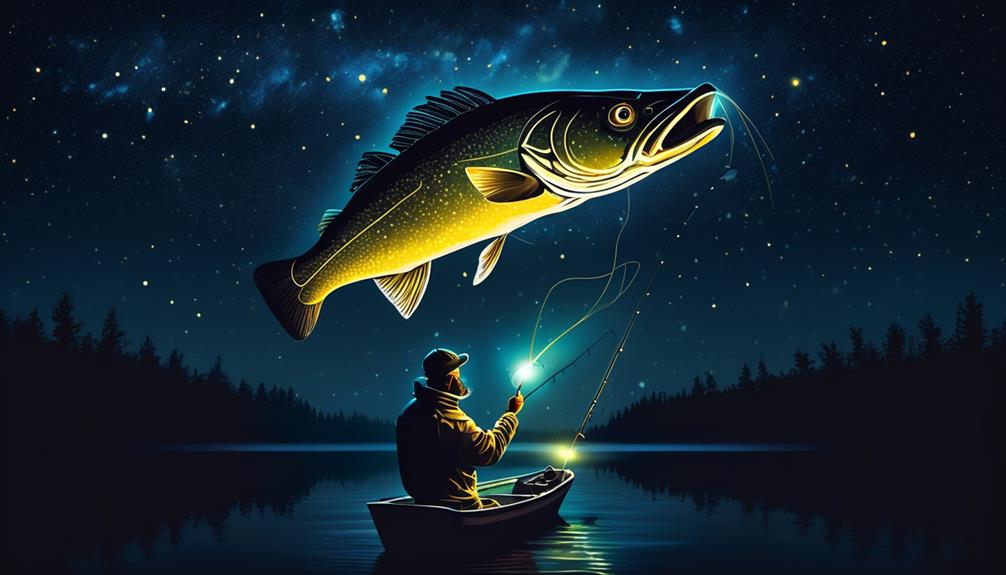
To maximize your chances of catching walleye at night, selecting the best bait and lures is essential. When it comes to night walleye fishing, using live bait can be highly effective. Nightcrawlers, minnows, and leeches are popular choices for live bait. They can be rigged on a slip sinker or a Lindy rig to keep the bait slightly off the bottom where walleye often feed at night.
Additionally, using scented soft plastic baits can also be productive. Consider using paddle-tail or curly-tail grubs in dark colors such as black, purple, or dark green to create a tempting presentation for walleye.
In terms of lures, crankbaits are a top choice for night walleye fishing. Deep-diving crankbaits in natural colors like silver, black, or blue can mimic the movement of baitfish, making them irresistible to walleye. When using crankbaits, it's important to vary the retrieval speed to find the right cadence that triggers strikes.
Another effective lure for night walleye fishing is the jigging spoon. With its flashy, erratic action, a jigging spoon can appeal to the walleye's predatory instincts, especially in low-light conditions.
Furthermore, don't overlook the effectiveness of glow-in-the-dark lures for night walleye fishing. These lures absorb light and emit a subtle glow, making them more visible to walleye in the darkness.
Whether using live bait or lures, it's crucial to experiment with different options to determine what the walleye are responding to on any given night.
Mastering Night Fishing Techniques
Mastering night fishing techniques requires honing your ability to adapt to low-light conditions and employing strategic approaches to attract walleye. To become proficient at night fishing, you must be patient and willing to experiment with different methods to find what works best for you. It's also essential to stay calm and focused, even when the darkness and silence seem overwhelming. Remember, the thrill of reeling in a walleye under the stars makes the effort worthwhile.
- Embrace the mystery of the night: Let go of any fear or hesitation and immerse yourself in the mystery and beauty of the night. The tranquil surroundings and the challenge of angling in the dark can be incredibly rewarding.
- Trust your instincts: Night fishing requires a heightened sense of intuition. Learn to trust your gut feelings and pay attention to subtle cues from the environment. Sometimes, it's the smallest details that lead to the biggest catches.
- Stay adaptable: The conditions can change rapidly at night, so it's crucial to remain adaptable. Be prepared to switch up your techniques and adjust your strategies as the night progresses.
- Enjoy the solitude: Night fishing offers a unique opportunity for solitude and reflection. Embrace the quiet moments and appreciate the peacefulness of the nighttime waters.
Locating Walleye Hotspots in the Dark

Locating walleye hotspots in the dark requires keen observation and an understanding of their nocturnal behavior. As the sun sets and darkness envelops the water, walleye become more active, moving closer to the shallows and seeking out prey. To locate these hotspots, start by identifying areas with structure, such as rocky points, submerged humps, or weed beds. These areas provide cover for the walleye and attract baitfish, making them prime hunting grounds for the nocturnal predators.
Pay attention to the water temperature, as walleye often prefer slightly warmer waters at night. Use a fish finder to locate thermoclines, where warmer water layers may attract walleye. Additionally, keep an eye out for any signs of activity on the water's surface, such as baitfish jumping or the occasional splash, as these could indicate the presence of feeding walleye.
Another effective technique for locating walleye hotspots in the dark is to utilize underwater lights. These lights attract plankton and baitfish, which in turn draw in walleye looking for an easy meal. Position your boat near the glow of the underwater lights and cast your lines into the surrounding darkness.
Lastly, consider the moon phase. During the full moon, walleye may be more active and visible near the surface, while they might stay deeper and more elusive during the new moon. By understanding these factors and observing the behavior of walleye at night, you can effectively pinpoint their hotspots and increase your chances of a successful night fishing expedition.
Adapting to Low-Light Conditions
Adapting to low-light conditions while night fishing for walleye requires keen observation and an understanding of how these nocturnal predators behave in the darkness. It can be challenging, but with the right techniques, you can improve your chances of a successful night fishing expedition.
Here's how you can adapt to low-light conditions:
- Use High-Quality Night Vision Gear: Investing in high-quality night vision gear can greatly enhance your ability to spot walleye in low-light conditions. The thrill of seeing these elusive creatures in the dark can be truly exhilarating.
- Master the Art of Patience: Night fishing for walleye demands patience. It's essential to remain calm and composed as you wait for the perfect opportunity to reel in your catch. The anticipation of a potential strike in the darkness can evoke a sense of excitement and mystery.
- Employ Sensitive Fishing Equipment: Utilizing sensitive fishing equipment, such as light action rods and high-quality fishing line, can help you feel even the slightest nibbles in the dark. The heightened sensitivity of your gear can evoke a sense of anticipation and readiness for the thrill of the catch.
- Embrace the Serenity of the Night: The tranquility of the night can be calming and mesmerizing. Embracing the peacefulness of the night while waiting for a walleye to bite can evoke a sense of connection with nature and a deep appreciation for the beauty of the nocturnal world.
Utilizing Technology for Night Fishing
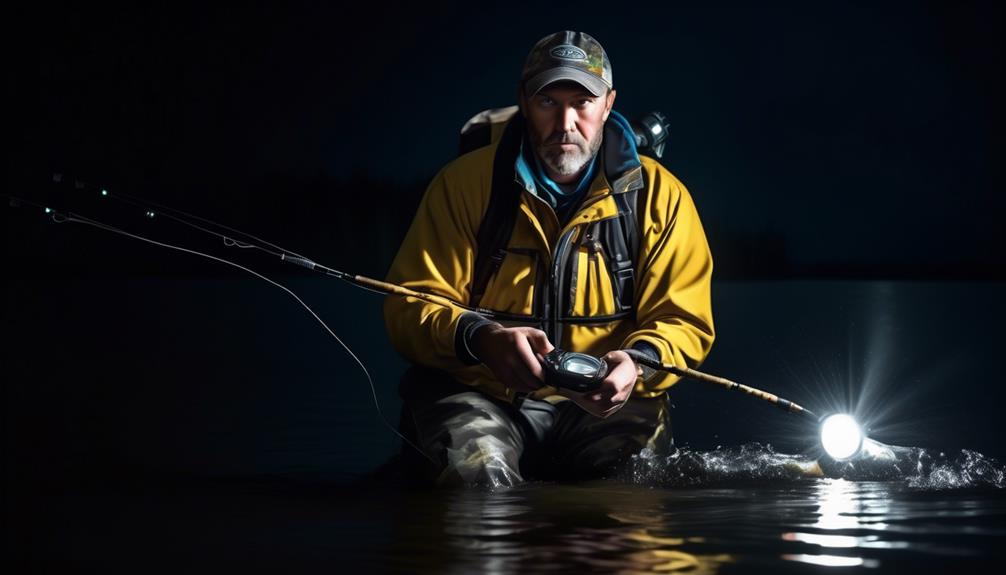
Enhancing your night fishing experience with modern technology can significantly elevate your chances of success in catching walleye during low-light conditions.
One of the most valuable tools for night fishing is a high-quality fish finder. Look for a fish finder specifically designed for low-light visibility, with features like bright, high-resolution displays and built-in LED backlighting. This will help you locate schools of walleye and understand their behavior in the dark.
Additionally, consider using a GPS unit to mark productive fishing spots and navigate safely in the dark. Modern GPS units often come with detailed mapping features, including depth contours and underwater structures, which can be vital for locating walleye hotspots at night. Some models even offer real-time mapping, allowing you to create personalized maps of your favorite fishing areas.
Another essential piece of technology for night walleye fishing is a reliable and bright headlamp. This hands-free lighting solution won't only illuminate your immediate surroundings but also provide visibility for tying knots, unhooking fish, and handling equipment. Look for a headlamp with adjustable brightness settings and a red light mode to preserve night vision.
Lastly, utilizing a thermal imaging camera can give you a significant advantage when searching for walleye in the dark. These cameras detect temperature differentials, helping you identify warm-blooded targets like walleye in cooler waters.
Staying Safe While Night Fishing
To ensure your safety while night fishing, always let someone know your planned fishing location and expected return time. This simple step can be crucial in case of an emergency or if you fail to return as planned.
In addition to informing someone of your whereabouts, there are several other important safety measures to keep in mind while night fishing:
- Carry a reliable light source: Darkness can be disorienting, especially on the water. Carrying a bright, waterproof flashlight or headlamp is essential for navigating your way around potential hazards and signaling for help if needed.
- Wear a personal flotation device (PFD): Accidents can happen, and wearing a PFD greatly increases your chances of staying safe in the water, especially at night when visibility is limited. Ensure that your PFD is Coast Guard-approved and properly fitted.
- Stay aware of your surroundings: Being vigilant of your environment is crucial for night fishing safety. Keep an eye out for other boaters, obstacles, and changes in weather conditions.
- Avoid alcohol and stay alert: Consuming alcohol while night fishing can impair your judgment and reaction time. Stay sharp and focused by avoiding alcohol consumption and getting enough rest before heading out.
Frequently Asked Questions
Can I Use the Same Fishing Techniques for Night Walleye Fishing as I Do During the Day?
You can use similar fishing techniques for night walleye fishing as you do during the day, but adjust for lower light conditions. Try using live bait or lures that produce vibrations or sound.
Are There Any Specific Regulations or Restrictions for Night Walleye Fishing That I Need to Be Aware Of?
Make sure to check local regulations for night walleye fishing, as there may be specific restrictions or requirements. It's important to be aware of any regulations that could impact your fishing experience.
How Do I Navigate the Water Safely and Effectively at Night While Walleye Fishing?
When night walleye fishing, use reliable navigation tools, like GPS and sonar, to safely maneuver the water. Maintain a slow, steady pace and be mindful of your surroundings. Keep a lookout for hazards and always wear a life jacket.
What Are Some Common Mistakes or Pitfalls to Avoid When Night Fishing for Walleye?
When night fishing for walleye, avoid using bright lights that can scare the fish. Also, steer clear of noisy movements and refrain from casting your line in the same spot repeatedly. Vary your bait presentation for better chances.
Are There Any Tips for Maintaining Visibility and Staying Alert During Night Walleye Fishing Trips?
To maintain visibility and stay alert during night walleye fishing trips, use headlamps with red or green light to preserve night vision, and take short breaks to stretch and refocus. Keep your equipment organized and accessible for efficiency.
Conclusion
So, next time you head out for a night walleye fishing excursion, remember to understand their behavior, choose the right equipment, and master the best techniques for success.
With the right bait and lures, locating hotspots, and adapting to low-light conditions, you'll be well-prepared for a successful night of fishing.
And don't forget to utilize technology and prioritize safety for a smooth and enjoyable experience on the water.
Happy fishing!
